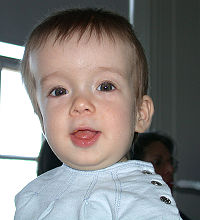
Photo from wikipedia
OBJECTIVE Skull fractures caused by birth injury are mainly compression and linear fractures, but the incidence is known to be rare. It has been recently suggested, however, that greenstick fractures… Click to show full abstract
OBJECTIVE Skull fractures caused by birth injury are mainly compression and linear fractures, but the incidence is known to be rare. It has been recently suggested, however, that greenstick fractures (GSFs) are more common than compression or linear fractures that are detected through 3-dimensional reconstructed computed tomography. Therefore, this study was conducted to determine the correlation of GSF with perinatal factors, the accompanying head injury factors, and the long-term outcomes in neonates. METHODS A retrospective study was conducted on correlations between GSF and perinatal and head injury factors for 295 neonates. In 160 neonates, the correlation with long-term outcome was investigated. RESULTS In 295 neonates, 47 cases had 3 or fewer GSFs, 66 cases had 4-6, 82 cases had 7-9, and 100 cases had 10 or more. The number of GSFs was significantly associated with gestational age and mode of delivery among the perinatal factors, with brain swelling and cephalohematoma among the head injury factors. It was also associated with long-term outcomes. The cut-off value of the number of GSFs for a poor outcome by the area under the receiver operating characteristic curve was 6 or greater. CONCLUSIONS It was concluded that GSF most commonly occurs as a birth-related skull fracture and that birth-related GSF is associated with perinatal factors, birth-related head injuries, and deterioration of long-term development. Therefore, efforts should be made to prevent GSF at birth.
Journal Title: World neurosurgery
Year Published: 2019
Link to full text (if available)
Share on Social Media: Sign Up to like & get
recommendations!